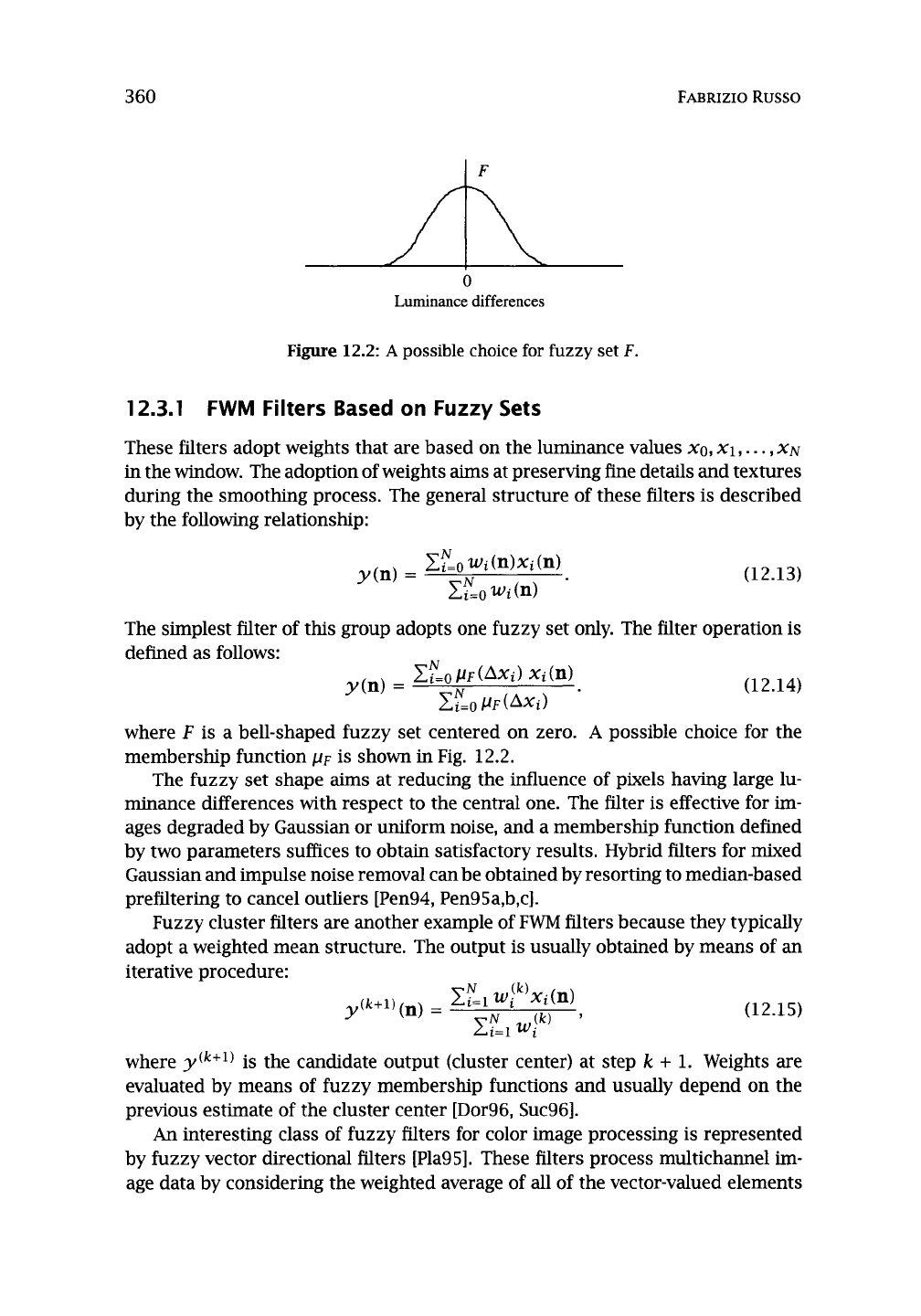
CHAPTER 12." NONLINEAR FILTERS BASED ON FUZZY MODELS
359
intersection connectives [Yag80]"
YI(Pl, P2, ..., Pn) = 1 - re_in 1, (1 - pi) p
i=1
1/p} .
(12.8)
Likewise, for an aggregation scheme ranging from maximum to unity (that is,
something more optimistic than the maximum), we can adopt the following class
of union aggregators:
: n{x
1/p} .
(12.9)
Finally, for an aggregation scheme ranging from minimum to maximum, we can
choose the generalized mean connective [Dyc84]:
lip
(12.10)
where Z in=l w i = 1. Indeed, this connective yields all values between minimum
and maximum by varying the parameter p between -co and + co.
Finally, we can resort to hybrid connectives to combine outputs of union and
intesection aggregators. The combination can be performed by using an additive
or a multiplicative model, respectively, as follows:
YH
= (1 --
u +
Y(Yu), (12.11)
YH = (YI) 1-y (yU) y.
(12.12)
The degree of compensation between the union and intersection components de-
pends on the value of the parameter u (0 < ), < 1).
12.3 Fuzzy Weighted Mean (FWM) Filters
These methods belong to the class of indirect approaches mentioned in Sec. 12.1.
FWM filters adopt fuzzy sets or fuzzy systems to evaluate the weights of a weighted
linear filter that, in turn, yields the output. To describe these and other nonlinear
techniques, we shall adopt a common mathematical notation. Suppose we deal
with digitized images having L gray levels. Let x(n) be the pixel luminance at
location n = [nx,
n2]
in the input image and let y(n) be the corresponding pixel
luminance in the output image (0 < x(n) < L - 1,0 < y(n) < L - 1). Let W(n) =
{xi(n); i = 0 .... ,N} be the set of pixel values which belong to a window around
x(n), where x0 = x(n). Finally, let Axi (n) = xi(n) - x (n) be the luminance
difference between the neighbor xi and the central pixel x.

360 FABRIZIO Russo
F
0
Luminance differences
Figure 12.2" A possible choice for
fuzzy
set F.
12.3.1 FWM Filters Based on Fuzzy Sets
These filters adopt weights that are based on the luminance values
Xo, x1,..., XN
in the window. The adoption of weights aims at preserving fine details and textures
during the smoothing process. The general structure of these filters is described
by the following relationship:
y(n) = ~'N=~
wi(n)xi(n).
(12.13)
N
Ei=o wi (n)
The simplest filter of this group adopts one fuzzy set only. The filter operation is
defined as follows:
y(n) =
EN=oI~F(~Xi)xi(n).
(12.14)
N
~'-i=0
[AF(AXi)
where F is a bell-shaped fuzzy set centered on zero. A possible choice for the
membership function/2F is shown in Fig. 12.2.
The fuzzy set shape aims at reducing the influence of pixels having large lu-
minance differences with respect to the central one. The filter is effective for im-
ages degraded by Gaussian or uniform noise, and a membership function defined
by two parameters suffices to obtain satisfactory results. Hybrid filters for mixed
Gaussian and impulse noise removal can be obtained by resorting to median-based
prefiltering to cancel outliers [Pen94, Pen95a,b,c].
Fuzzy cluster filters are another example of FWM filters because they typically
adopt a weighted mean structure. The output is usually obtained by means of an
iterative procedure:
. (k)
y(k+l)(n) = ~'iN1
wi
xi(n)
(k) ' (12.15)
where y(k+l) is the candidate output (cluster center) at step k + 1. Weights are
evaluated by means of fuzzy membership functions and usually depend on the
previous estimate of the cluster center [Dor96, Suc96].
An interesting class of fuzzy filters for color image processing is represented
by fuzzy vector directional filters [Pla95]. These filters process multichannel im-
age data by considering the weighted average of all of the vector-valued elements
Get Nonlinear Image Processing now with the O’Reilly learning platform.
O’Reilly members experience books, live events, courses curated by job role, and more from O’Reilly and nearly 200 top publishers.

